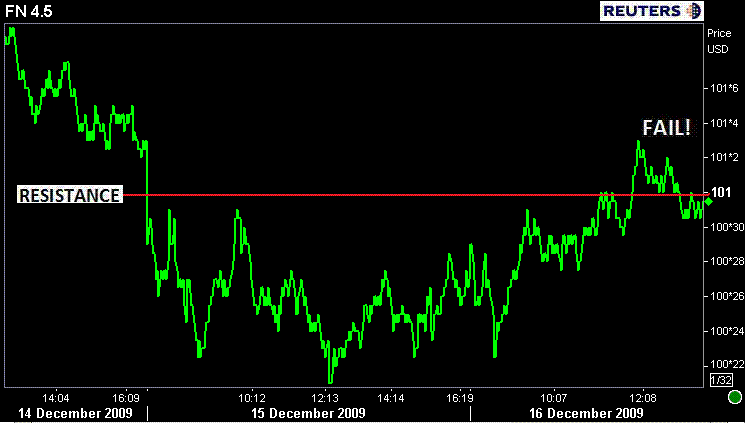T-Minus 60 minutes until the FOMC Statement is released.
This morning I explained the underlying rationale of a "real money buyer". When applying their normal long term bias and current year end strategies to recent price action, one could say they have been the supportive influence that helped 10s avoid a breakdown of 3.62% support and the force which just pushed 10s through 3.57% resistance a few minutes ago. To be clear, view them as "bargain buyers" looking to snatch up higher yields while they can before the quarter comes to a close. Although this is a function of year end "window dressing" in general, remember a "real money account" is not speculative in nature, instead they are matching and managing any discrepancy between the life of outgoing cash flows and incoming cash flows...while looking to put their assets to work at a greater return (looking for yield spread).
So who has been preventing rates from making further progress?
Everyone else.
Fast money traders mostly. This includes professional traders, portfolio managers, and hedge funds who are essentially day trading the market. These market participants are heavily reliant on their "BLACK BOX", or trading models, to send buy or sell signals. The recent bearish bias in the rates market (yield curve steeper) is keeping these accounts defensive of their intraday gains. When price appreciations do occur...these traders have been taking profits...which has prevented notable progress away from the 3.57% pivot point.
You can see these different strategies battling it out this morning in the chart below.
The below chart illustrates the combined effect of "real money" buying at the lows, followed by short covering from fast money, then more profit taking from day traders at the highs.3.57% was broken for a bit, but prices have since stabilized back near the 3.57% pivot. I would also like to bring up another observation. Yesterday the fixed income market sold off as traders priced in an inflation discount following some warmer than expected PPI data, today CPI data was as expected....and the market has taken back that discount and returned yields to pre-PPI levels. Let's call this returning to "Status Quo" ahead of the FOMC statement.
When 10s broke 3.57 and moved down to 3.54, the FN 4.5 ticked over 101-00. However once trade flows balanced out and 10s moved back up to 3.57, the FN 4.5 fell back below 101-00. This is obviously our sentiment indicator...if the FN 4.5 breaks out over 101-00 and holds, it will be good news for mortgage rates in the short term.
The FN 4.0 is currently +0-10 at 98-08 yielding 4.169% and the FN 4.5 is +0-04 at 100-31 yielding 4.405%. The secondary market current coupon is 4.358%. The current coupon yield is 80bps over the 10yr note yield and 65 bps over the 10yr swap rate.

Looking ahead, I do believe a Fed Statement that highlights SUBSTANTIAL RESOURCE SLACK and STILL WEAK INFLATIONARY PRESSURES will be beneficial to the bond market...in the short run. However, further ahead, as in EARLY 2010, I find it difficult to present an argument for higher or lower rates as most market participants will be starting fresh, looking at data for directional hints and trying to figure out how regulatory reform and the Fed's exit from several liquidity facilities will affect the yield curve. But again...I think I have also made it clear that I see more reason for rates to rise than to fall in Q1 2010.







